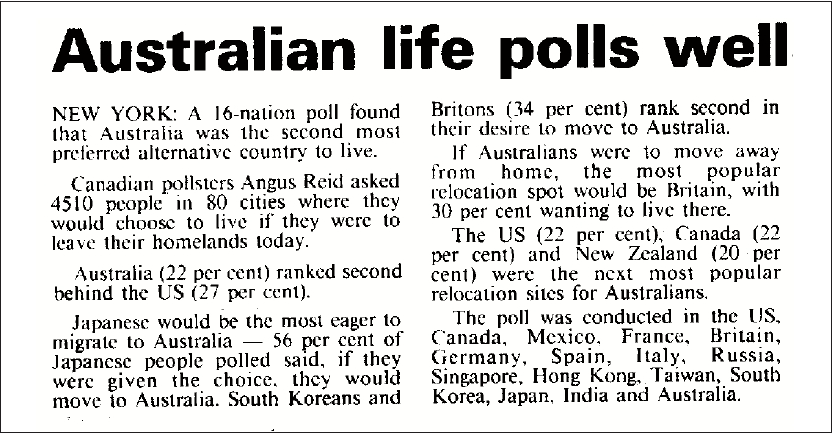Adding together the bits -- what might be called the Accounting Technique -- is one which operates from the bottom up. Add together all the little bits at the bottom, say all the people in a city, and you end up with a 'top' figure, the municipal population.
There is another way. It avoids deficiencies in accounting-technique formulas by dispensing with them. Instead, quite a different technique is used, one which operates from the top down.
As an example, it would be possible to measure a city population by going to the local stadium at the time of the annual North-of-the-River v. South-of-the-River football match, which everyone attends, and estimating how full it is. If the stadium holds 100,000 and it is 75% full, the city population is 75,000.
Now obviously that approach is very simplified. It could be made more exact by estimating the fraction of population who did not actually attend, say by local water consumption from flushing toilets, and the number actually at the match could be estimated more precisely, say from peak noise levels, body heat emitted from the whole stadium, or change in light absorption determined from a satellite photo. And just as obviously, any such approach cannot be exact.
Top-down methods of measurement are intrinsically open to the criticism that they are inexact. If the quantity being measured is not a matrix one, it may well be that an 'accounting' technique is available which does appear exact. Even here, though, it is possible to confuse an exact method of counting with an exact method of measuring -- there may be a discrepancy between what is actually counted and what is intended to be measured.
For the football match, a turnstile count will be one which is close to exact. But remember, it was the city population we were trying to measure. Even if the quantity we are measuring is an additive one, it does not follow that methods are available which truly perform the desired summation accurately.
For a non-additive quantity, for example matrix quantities like infocap, we can only use an alternative approach. Let us now look for one.
The Synenergy Meter
Back in MT102 we sketched a picture of a country represented as a black box, with a dial on the front marked 'Infocap'. That concept was a purely mental one. Let us now try to devise a real technique, one capable of measuring how much synenergy a country contains.In previous articles we have referred to synenergy as based on infocap in motion, or as infocap 'quickened' by addition of some other factor in syston makeup. Infocap itself can be regarded as the substance which makes up the 'worth' of a syston. One aspect of infocap is money.
 Fig. 115.1. Advertisement from the
'Weekend Australian', 1991 April 6-7
Fig. 115.1. Advertisement from the
'Weekend Australian', 1991 April 6-7
Of course procedures already exist to estimate the money ranking of a country, such as the Gross National Product per capita mentioned in MT109. Now GNP is worked out on additive, 'accounting' principles -- a typical example of bottom-up methods. Note also that, in common with 'bottom-up' methods, the result is measured in familiar units -- say in US dollars per person per year.
Matrix Thinking by definition looks at a situation from the outside, and to measure a matrix quantity we necessarily need to work top-down, from the broadest aspect. Look now at the advert in Figure 115.1.
This advert appeared in, and was repeated in, an Australian newspaper in 1991. It is an interesting item in itself, with its reference to 'Green Card Lotteries', and the offer of advice on filling out forms with 'winning answers', getting U.S. citizenship, and avoiding deportation.
It is also interesting in the ordering format offered, with the facility for making a free international telephone call and charging the book to a credit card. This advert was the first reference I had seen in Australia to the existence of an 0014 Overseas Freephone service; Australia's established telephone utility, Telstra, does not mention it, although they do describe the free-to- caller internal 1800 service.
But the real impact and relevance of this advert is that it should appear at all. For it to be worth someone's while to pay for such an ad, and repeat it later, it can be assumed that a response was expected and obtained. The existence of the ad implies that readers in Australia will be interested in migrating to the USA.
The Grass is Greener . . .
The grass is always greener on the other side of the fence, and there will always be people who have a desire to live somewhere else. What we need to do in the current aim of constructing a Synenergy Meter is to quantify the urges involved in the desire to move. Consider the following news item.
Now of course these polls will not necessarily reflect migration movements which are in progress or may occur in the future. When it comes down to the actual process (or trial) of migrating, and all the hidden bureaucratic and discrimination rebuffs are met with head-on, a rosy view of a particular migration target might quickly vanish.
But that does not matter in the present case. The basis for the proposed Synenergy Meter is the idea that the perceived attractiveness of a particular country as a migration target does give a measure of some attribute that country possesses, and that attribute is the same thing as what has been called the 'synenergy' of the country in this suite of articles.
Proposition 115A**. The synenergy of a syston is reflected in the urges of systels outside
the syston to enter it
We should look carefully at what this suggestion really means. It is not just saying that a country with a lot of synenergy will be likely to attract visitors and migrants, although this is implicit. What it is saying, is that the 'attractiveness' of a country as a place to visit or live in reflects the basic quantity of a substance that country possesses, a quantity which we have called synenergy. The synenergy content is fundamental, measuring its attractiveness accurately is a way to measure its synenergy.
In fact at present we cannot make such a measurement very accurately. But we can make progress towards this.
The Message in the Rocks
In the early development of the modern science of geology, ways of measuring the absolute ages (ages in years) of different rock strata had not been worked out, but it was possible to work out their relative agesFor example, in many parts of the world it is possible to find good exposures of long successions of rock strata. Within these successions, there may be layer after layer of rock, all essentially horizontal, and showing no sign of any dramatic event such as overturning in a mountain-building event. With drill-holes, some of these undisturbed rock sequences may be traced to very considerable depths, measured in kilometres.
Of course it is only logical that in an undisturbed sequence of rock deposition, the younger rocks will be on top of the older ones. Moreover, because all forms of life are continually evolving, fossils found in the different strata identify their relative ages and connection with similar strata elsewhere in the world. And of course some creatures had a long geological record, some short ones, and with a given assembly of different fossils from the same stratum it is possible to pin down the relative ages of the rocks involved quite well.
Sometimes the boundaries are remarkably precise. Once, in my youth, I climbed up one of the cliffs at the side of the Severn Gorge in England, to view the Triassic-Jurassic boundary, the division between two of the 16 major age divisions into which the Earth's rocks are usually classed.
Reaching almost to the top, with my arm over the edge, I lost my footing and fell. As I flashed by the Tea-Green Marls just below the classic boundary, and fell through millions of years of deposition in a few seconds, I realized that my geological hammer was still at the top.
Luckily I wasn't badly hurt. I climbed up the face again, reached the top, and fell again -- but this time my hammer came down with me. And I had a piece of the Rhaetic Unconformity, a slice of history around 198 million years old, and only a centimetre or so thick.
A Crude Beginning
When we come now to our synenergy measurement, we are in a similar position to that of the early geologists. Using data such as that mentioned in Figure 115.2, we can place countries on a scale of migration attractiveness, and call their rating on the scale their synenergy content. And we can get not only a relative rating -- Australia above Canada, say -- but also a quantitative measure, perhaps with Australia 5 notches above Canada but 10 notches below the USA.Note, however, that we have no absolute units to state the synenergy content in, we cannot say that Australia has a content of 198 million megasynergs or some such. For that we will need to develop analogues of the potassium-argon dating of rocks. Note also that the synenergy measuring technique is a top-down one, we don't sum up any smaller bits, only sample from a large continuum.
More importantly, note that Synenergy Rating has no necessary connection with conventional measures of a country's worth, such as GNP, Gross National Product. GNP does attempt to measure assets in monetary terms, and money is one form of infocap, true enough. The point is that synenergy embraces far, far more than this one money component.
And so, while the United States may be at the top of both the GNP and Synergy scales, there is no general relationship. Japan, Switzerland, the Scandinavian countries -- these all have high GNP values, but is there a big rush to migrate there? I would be surprised if they were even mentioned as migration targets in a Fig. 115.2 poll. While Brazil or Indonesia -- certainly not rich countries in conventional terms -- could well be places where people might want to 'make a fresh commitment'.
Small Towns in Nebraska
We have looked at the attractiveness of countries as migration targets, and derived a technique for measuring their synenergy. With systons of other sizes or natures, we could look at other measurement techniques which might be applicable. To measure the ages of comparatively young fossils, we might need to switch from potassium-argon to carbon dating.In an article in Research Nebraska [Reference 15], a study is reported of changes in the attractiveness of variously-sized Nebraska towns as retailing centres. Economist Bruce Johnson worked out a technique called 'pull factor analysis' to reflect these changes.
Pull factor is the 'per capita retail sales of a county or town divided by the state per capita retail sales for the same period'. What this means is, that if a retail centre has a pull factor greater than 1.00, it is holding its share of retail trade, while if it has a factor below 1.00, it is losing out to other centres.
Johnson found that the smallest centres were the greatest sufferers. In the period 1970 to 1988, the average pull factor for towns under 500 population fell from 1.08 to 0.60. For towns in the 500 to 1,000 population range, the factor fell, on average, from 1.02 to 0.74. Towns with between 1,000 and 10,000 population also declined somewhat, while those with more than 20,000 inhabitants were the winners.
Such figures may be saddening, but they are not surprising. The 'Magnet of the City', the 'Depopulation of the Countryside', these are common features of modern life all over the world. In MT terms, they are normal reflections of the tendency of infocap to aggregate and build up synenergy focussing and breeding nodes.
What this last study provides is another instance of a way of measuring synenergy content. It may not be exact, and it is still only relative, but it is a start. Let us now leave this topic and move to a completely different area -- the study of syston governments (MT116), the overt managers of syston operations.

